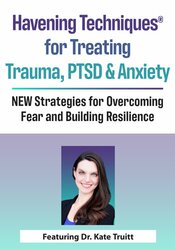Building Resilience with Neuroplasticity, Cognitive Framing, and the Havening Touch
A powerful demonstration with Dr. Kate Truitt

The Creating Possibilities Protocol (CPP) is a resilience-building neuroplasticity exercise. It utilizes cognitive framing to enhance a preferred emotion or state, as well as to craft within the brain the neural pathways of emotions, beliefs, and preferred cognitions.
It can be particularly helpful for clients who feel affirmations are inauthentic or whose brains struggle to link into the things they want to feel and believe about themselves.
A neurobiological factor of this struggle, also sometimes called “resistance” in the psychotherapy world, is that the client’s survival brain has used the painful emotion state or maladaptive belief as a way of helping the client make sense of the world or to keep them safe. Trying to feel or think differently can trigger major alarm bells in the client’s survival brain.
When we run into “resistance” in a clinical session, CPP becomes a useful tool for gently working with the survival brain resistance until the client can start slowly building into a more preferred state of being.
CPP integrates the havening touch to regulate the nervous system and allow the thinking brain to be more accessible to our clients in their healing work. The havening touch involves a gliding touch over the brow and cheekbones, crossing the arms to the shoulders and gliding downward to the elbows in a moving hug, and gently rubbing the palms together as if washing hands. For a deeper dive into the underlying mechanics of the havening touch, check out this blog: Introducing the Havening Touch: The Neurobiological Superpower We Hold in Our Hands.
This protocol builds or strengthens a preferred emotion or resilient belief.
Tip: If at any point in this process, the client becomes distressed or activated, you can begin CPR for the Amygdala® to help them rapidly calm and regulate. Learn more about this technique in my blog: Reduce Anxiety with Self-Havening Touch and Breathwork.
Remember: Our brain and body know if we’re lying to it. That twinge of disagreement, imposter syndrome, or anxiety is the survival brain letting our client know their brain is not yet ready to go to the next step. If something does not feel authentic to the client in the moment, that is okay! We model for them the empowerment of honoring the authentic information of how they feel in the moment. Any time the client is not ready to move on to the next step of the protocol, take the opportunity to praise their willingness to honor exactly where they are on their healing journey and not lie to their brain.
It can be particularly helpful for clients who feel affirmations are inauthentic or whose brains struggle to link into the things they want to feel and believe about themselves.
A neurobiological factor of this struggle, also sometimes called “resistance” in the psychotherapy world, is that the client’s survival brain has used the painful emotion state or maladaptive belief as a way of helping the client make sense of the world or to keep them safe. Trying to feel or think differently can trigger major alarm bells in the client’s survival brain.
When we run into “resistance” in a clinical session, CPP becomes a useful tool for gently working with the survival brain resistance until the client can start slowly building into a more preferred state of being.
CPP integrates the havening touch to regulate the nervous system and allow the thinking brain to be more accessible to our clients in their healing work. The havening touch involves a gliding touch over the brow and cheekbones, crossing the arms to the shoulders and gliding downward to the elbows in a moving hug, and gently rubbing the palms together as if washing hands. For a deeper dive into the underlying mechanics of the havening touch, check out this blog: Introducing the Havening Touch: The Neurobiological Superpower We Hold in Our Hands.
The Creating Possibilities Protocol
This protocol builds or strengthens a preferred emotion or resilient belief.
Tip: If at any point in this process, the client becomes distressed or activated, you can begin CPR for the Amygdala® to help them rapidly calm and regulate. Learn more about this technique in my blog: Reduce Anxiety with Self-Havening Touch and Breathwork.
- 1. Identify the Target: Have the client choose an emotion they would like to enhance, or identify the preferred belief about self they are struggling to connect with.
2. Identify the Anchor: Have them recall a time where they experienced that emotion, or have them bring to mind a person or color that represents this state or belief for them. Common figures are superheroes, animals, historical figures, etc.
3. Begin applying the havening touch (hands, arms, and face in any order) and continue throughout.
4. Build Curiosity: Have the client mentally focus on that Target and Anchor while asking aloud the question “What if I ___?” filling in the blank with their preferred emotion or belief. Have them repeat the question 5 or more times, or until they begin to experience the state, or it feels within the realm of possibility. Encourage the client to be curious. They do not have to force themselves to feel or believe anything. Instead, they are simply posing the possibility to their brains.
5. Build Capability: If the client indicates the Target is in the realm of possibility, ask if they feel they can be their chosen state. If so, they can repeat “I can___." 5 or more times. If not, have the client stick with the "What if I was __?" encouraging their brain to explore the possibilities of this emotion, state or belief.
6. Build Agency: Ask the client if they think they will be their chosen state. They do not have to know the future or they would feel this way forever. Instead, they can just consider if they may feel this way 5 seconds from now. If so, they will repeat "I will ___." 5 or more times. If not, stick with the "What if I was __?"
7. Build Empowerment: Finally, encourage the client to consider the affirmative version of their preferred emotion, state, or belief (“I am calm,” “I am worthy of love,” “I am able to make friends,” etc.). On a scale of 0-100%, how true does it feel to them? If and only if the client reports this step feels fully true and authentic to them in the moment (somewhere between 95-100% true) encourage the client to speak aloud the affirmation “I am ___." 5 or more times. If it does not feel 95-100% true, stick with the "What if ___?" and encourage curiosity.
Remember: Our brain and body know if we’re lying to it. That twinge of disagreement, imposter syndrome, or anxiety is the survival brain letting our client know their brain is not yet ready to go to the next step. If something does not feel authentic to the client in the moment, that is okay! We model for them the empowerment of honoring the authentic information of how they feel in the moment. Any time the client is not ready to move on to the next step of the protocol, take the opportunity to praise their willingness to honor exactly where they are on their healing journey and not lie to their brain.
Create New Pathways to Sustainable Change in Your Clients' Lives

If you treat clients who experience anxiety, trauma, depression, pain, panic or any other stress-based disorder, then no doubt you’ve had moments of feeling helpless watching a client paralyzed by their harmful core beliefs or triggers of traumatic experiences.
Wouldn’t it be great having highly effective easy-to-use tools that directly address the emotions keeping your clients stuck in painful pasts and unable to realize a brighter future?
Utilizing similar mechanisms as Eye Movement Desensitization and Reprocessing (EMDR), Havening Techniques are a new suite of neuroscience-based interventions designed for fast and effective treatment of posttraumatic stress disorder and other fear-based disorders such as anxiety, panic disorder, and phobias – whether your clients are in session, at home or on the go – whenever difficult emotions come at unexpected times!
Join Havening Techniques Certified Trainer and Global Director of Continuing Education, Dr. Kate Truitt, for this must-see webcast and discover her secrets for creating a gentle, clientcentered approach to trauma-informed, neuroscience-based, and resiliency-focused care.
Wouldn’t it be great having highly effective easy-to-use tools that directly address the emotions keeping your clients stuck in painful pasts and unable to realize a brighter future?
Utilizing similar mechanisms as Eye Movement Desensitization and Reprocessing (EMDR), Havening Techniques are a new suite of neuroscience-based interventions designed for fast and effective treatment of posttraumatic stress disorder and other fear-based disorders such as anxiety, panic disorder, and phobias – whether your clients are in session, at home or on the go – whenever difficult emotions come at unexpected times!
Join Havening Techniques Certified Trainer and Global Director of Continuing Education, Dr. Kate Truitt, for this must-see webcast and discover her secrets for creating a gentle, clientcentered approach to trauma-informed, neuroscience-based, and resiliency-focused care.
Meet the Expert:
Dr. Kate Truitt is a neuroscientist and clinical psychologist with an MBA in Healthcare Administration. She has dedicated her life to advancing the treatment of trauma and stress-related disorders. Dr. Truitt is the founder and President of Dr. Kate Truitt & Associates - a neuroscience-based group therapy practice in Pasadena, and the CEO of the Trauma Counseling Center (TCC), with offices throughout Los Angeles. She founded Viva Excellence to provide cutting-edge training and seminars globally that bring together the newest advancements in the fields of neuroscience and resiliency, as well as stress and trauma treatments. Her clinical practice, scientific studies, and trainings are specialized in the treatment of PTSD/Complex Trauma, panic disorders and anxiety, phobias, as well as other stress-related disorders. Her research is on brain health during the recovery process, treatment outcomes, and provides trainings on trauma as well as personal empowerment. Dr. Truitt founded and is the Chairman of the Board for the Amy Research Foundation, a 501c3 organization to advance research into the innovative treatment realm of neuroscience-based mental health treatment. She is also a Certified Trainer as well as the Global Director of Continuing Education for the Havening Techniques.
Dr. Truitt knows that when we choose to let every moment of adversity strengthen and empower us, we are choosing to be our strongest and most empowered selves. Her treatment model consists of three core pillars: trauma informed, neuroscience based, and resiliency focused care, which empowers clinicians to become proactive guides in the client's transformational journeys as they seek and obtain their fulfilled life.
Learn more about their educational products, including upcoming live seminars, by clicking here.
Dr. Truitt knows that when we choose to let every moment of adversity strengthen and empower us, we are choosing to be our strongest and most empowered selves. Her treatment model consists of three core pillars: trauma informed, neuroscience based, and resiliency focused care, which empowers clinicians to become proactive guides in the client's transformational journeys as they seek and obtain their fulfilled life.
Learn more about their educational products, including upcoming live seminars, by clicking here.





